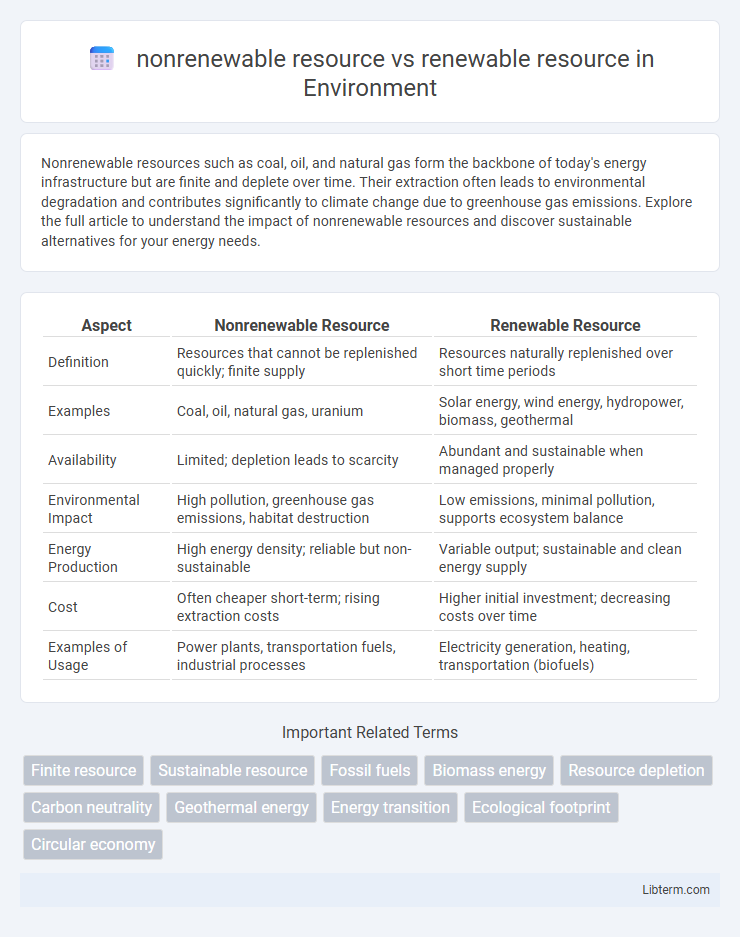Nonrenewable resources such as coal, oil, and natural gas form the backbone of today's energy infrastructure but are finite and deplete over time. Their extraction often leads to environmental degradation and contributes significantly to climate change due to greenhouse gas emissions. Explore the full article to understand the impact of nonrenewable resources and discover sustainable alternatives for your energy needs.
Table of Comparison
| Aspect | Nonrenewable Resource | Renewable Resource |
|---|---|---|
| Definition | Resources that cannot be replenished quickly; finite supply | Resources naturally replenished over short time periods |
| Examples | Coal, oil, natural gas, uranium | Solar energy, wind energy, hydropower, biomass, geothermal |
| Availability | Limited; depletion leads to scarcity | Abundant and sustainable when managed properly |
| Environmental Impact | High pollution, greenhouse gas emissions, habitat destruction | Low emissions, minimal pollution, supports ecosystem balance |
| Energy Production | High energy density; reliable but non-sustainable | Variable output; sustainable and clean energy supply |
| Cost | Often cheaper short-term; rising extraction costs | Higher initial investment; decreasing costs over time |
| Examples of Usage | Power plants, transportation fuels, industrial processes | Electricity generation, heating, transportation (biofuels) |
Understanding Renewable and Nonrenewable Resources
Renewable resources are natural assets that replenish continuously over time, such as solar energy, wind, and biomass, ensuring sustainable availability. Nonrenewable resources, including fossil fuels like coal, oil, and natural gas, exist in finite quantities and deplete with extensive use, leading to environmental and economic concerns. Understanding the distinction between these resources is crucial for developing long-term energy strategies and minimizing ecological impact through increased reliance on renewables.
Key Differences Between Renewable and Nonrenewable Resources
Renewable resources, such as solar, wind, and hydro energy, are naturally replenished within a human lifespan, making them sustainable for long-term use; nonrenewable resources like coal, oil, and natural gas exist in finite quantities and take millions of years to form. Renewable resources emit lower greenhouse gases and have less environmental impact compared to nonrenewable resources, which are major contributors to pollution and climate change. Economic factors also differ, as renewable energy systems often have higher initial costs but lower operational expenses, while nonrenewable resource extraction and use can lead to price volatility and resource depletion.
Examples of Nonrenewable Resources
Nonrenewable resources include fossil fuels such as coal, oil, and natural gas, which are formed over millions of years from organic matter and are finite in supply. Minerals like gold, uranium, and copper are also classified as nonrenewable because they cannot be replenished on a human timescale. These resources are contrasted with renewable resources like solar, wind, and biomass energy that are naturally replenished and sustainable for long-term use.
Common Types of Renewable Resources
Solar, wind, and hydropower are the most common types of renewable resources, providing sustainable energy with minimal environmental impact. Biomass and geothermal energy also contribute significantly to renewable resource portfolios by utilizing organic materials and Earth's internal heat. These resources regenerate naturally, contrasting with nonrenewable sources like coal and oil that deplete finite reserves.
Environmental Impact Comparison
Nonrenewable resources such as coal, oil, and natural gas contribute significantly to environmental degradation through greenhouse gas emissions, air and water pollution, and habitat destruction. Renewable resources like solar, wind, and hydroelectric power offer a cleaner alternative by producing energy with minimal emissions and lower ecological footprints. Transitioning to renewable energy sources is crucial for reducing carbon emissions and mitigating climate change impacts.
Economic Implications of Resource Use
Nonrenewable resources, such as fossil fuels and minerals, often lead to volatile market prices due to their finite supply, causing economic instability and increased extraction costs over time. Renewable resources, including solar and wind energy, provide more stable long-term economic benefits by reducing dependency on imports and lowering operational costs through sustainable use. Investment in renewable technologies promotes job creation and energy security, which drives economic growth and resilience against resource depletion shocks.
Sustainability Challenges and Solutions
Nonrenewable resources such as fossil fuels present significant sustainability challenges due to their finite availability and environmental impact, including greenhouse gas emissions and habitat destruction. Renewable resources like solar and wind energy offer sustainable solutions by providing continuous energy supply with minimal ecological footprint, yet they require advancements in storage technology and infrastructure integration. Transitioning to a renewable-based economy demands systemic changes in energy policy, investment in innovation, and global cooperation to address resource depletion and climate change effectively.
Technological Innovations in Resource Management
Technological innovations in resource management have significantly improved the efficiency and sustainability of renewable resource utilization, such as advanced solar panels and wind turbine designs that maximize energy capture. In contrast, nonrenewable resource management increasingly employs technologies like carbon capture and storage (CCS) and enhanced oil recovery (EOR) to reduce environmental impact and extend resource lifespans. Smart grid systems and AI-driven analytics optimize consumption patterns and resource allocation across both renewable and nonrenewable sectors, promoting balanced energy transition strategies.
Future Outlook for Global Resource Consumption
Global resource consumption is projected to shift significantly toward renewable resources due to rising environmental concerns and technological advancements in energy efficiency and storage. Nonrenewable resources, such as fossil fuels and minerals, face depletion risks and increased regulatory restrictions that drive the transition to sustainable alternatives. Emerging global policies and market trends indicate accelerated investment in solar, wind, and bioenergy, fostering a cleaner and more resilient energy future.
Promoting a Transition to Renewable Resources
Promoting a transition to renewable resources involves shifting energy production from finite nonrenewable sources like coal, oil, and natural gas to sustainable alternatives such as solar, wind, and hydropower. Renewable resources offer lower carbon emissions, reducing environmental impact and mitigating climate change. Investing in renewable energy infrastructure and technology advances accelerates this global shift towards cleaner, more resilient power systems.
nonrenewable resource Infographic

 libterm.com
libterm.com